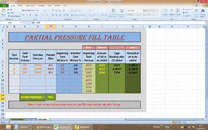jwalko
Contributor
Hi all:
Not sure if this post belongs here...but wasn't sure where else to post it.
Back story...taking my tanks to my dive shop for a nitrox fill. They are currently filled with air. I am going on a dive trip in a couple of weeks and want 32%. I asked them if they can do a partial pressure fill and they said yes...they'll bleed off the tanks and then top off to get to 32%.
This got me thinking about the math involved in figuring out how much to bleed off and then how much to add to get to the right %.
I know there are software tools available, but I really want to understand the math. Not that I don't trust the tools...but I'm the kind of person who wants to understand how things work. Can someone either point me in the right direction for reading materials, or give me the formula for figuring out a couple of different scenarios...
Scenario 1, I have tanks full...want to bleed off part and add 50% or 100% 02 to get to a certain percentage (say 32% or 36%). As an example, I have an 85 cu ft LP steel tank (2600 PSI) with 2600 lbs currently in it. How much do I bleed off and then add 02 to get to 32%?
Scenario 2, tanks are empty (I know this used to be standard for PP blending...but I'm curious if it still is...my shop indicated that it wasn't necessary), how much 02 to add, and then top off with air to get to a certain percentage.
This is for my knowledge only...I'm not going to try to do my own blending...I just want to understand it.
Thanks;
John
Not sure if this post belongs here...but wasn't sure where else to post it.
Back story...taking my tanks to my dive shop for a nitrox fill. They are currently filled with air. I am going on a dive trip in a couple of weeks and want 32%. I asked them if they can do a partial pressure fill and they said yes...they'll bleed off the tanks and then top off to get to 32%.
This got me thinking about the math involved in figuring out how much to bleed off and then how much to add to get to the right %.
I know there are software tools available, but I really want to understand the math. Not that I don't trust the tools...but I'm the kind of person who wants to understand how things work. Can someone either point me in the right direction for reading materials, or give me the formula for figuring out a couple of different scenarios...
Scenario 1, I have tanks full...want to bleed off part and add 50% or 100% 02 to get to a certain percentage (say 32% or 36%). As an example, I have an 85 cu ft LP steel tank (2600 PSI) with 2600 lbs currently in it. How much do I bleed off and then add 02 to get to 32%?
Scenario 2, tanks are empty (I know this used to be standard for PP blending...but I'm curious if it still is...my shop indicated that it wasn't necessary), how much 02 to add, and then top off with air to get to a certain percentage.
This is for my knowledge only...I'm not going to try to do my own blending...I just want to understand it.
Thanks;
John





